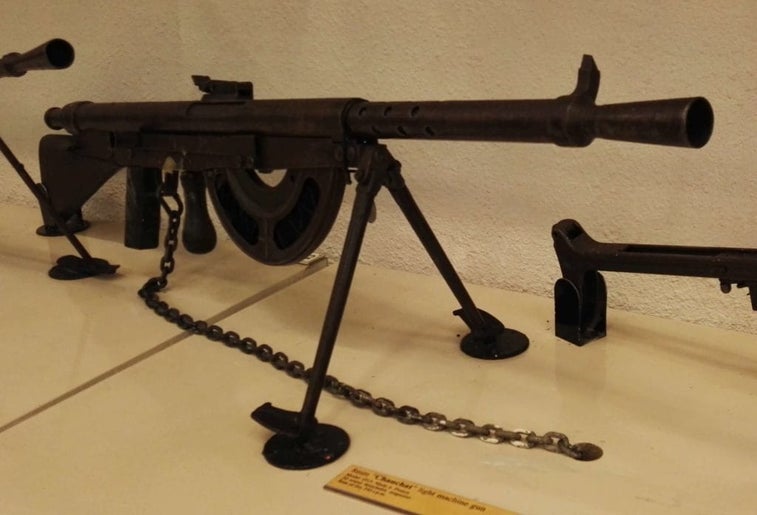Depending on the gunner and conditions, a barrel modification could be needed as frequently as every 200 to 250 rounds. When the hot barrel was removed, it was reserved up until it was cool enough to utilize again. Machine-gun teams would have as many as 6 spare barrels on hand.
Driving through a just recently secured location in Belgium, the sharp-eyed Liniewski found the abandoned weapon in a field. Liniewski then did what any not being watched GI would have performed in that position; he stopped his truck and took the opportunity to snag an excellent memento for the folks back home. As a support soldier, Liniewski was not familiar enough with weapons to dismantle his MG-42, so he hung on to it for a while till he found a camp where German detainees of war were being held.
The weapon remained in the Liniewski family till 2016 when his child Marty contributed the weapon to the Museum. In spite of its propensity to get too hot, the MG-42 was an excellent weapon that was light-years of ahead of the US equivalent, the Browning M-1919A4 maker gun. Germany produced approximately 400,000 MG-42s throughout the war, some of which are still in active duty.

Taken together, all these weapons gave the Red Army a more practical variety of support weapons, better able to challenge the Germans for fire superiority on the battleground. Completely illustrated, this study explains the innovation and the techniques of these device guns. Noted authority Chris Mc, Nab sets out how these maker guns were dispersed and tactically used and provides many examples of the weapons in action, from assault groups on the streets of Stalingrad to tank crews struggling for survival at Kursk.
All About Machine Guns In World War I
Illustrated with high-quality pictures and specially commissioned art work, this is a deep analysis of these essential tools of warfare within the Soviet forces.
Taken together, all these weapons provided the Red Army a more useful series of assistance weapons, better able to challenge the Germans for fire superiority on the battleground. Fully illustrated, this research study describes the technology and the techniques of these maker guns. Noted authority Chris Mc, Nab sets out how these gatling gun were dispersed and tactically used and offers many examples of the weapons in action, from assault groups on the streets of Stalingrad to tank crews struggling for survival at Kursk.
Illustrated with top quality pictures and specifically commissioned art work, this is a deep analysis of these essential tools of warfare within the Soviet forces.
The device gun business, commanded by a captain, had an assigned strength of 6 commissioned officers and 172 gotten men, and brought 16 weapons, four of which were spares. Within the company there were three squads and a headquarters area. A first lieutenant led the first platoon, while second lieutenants led squads 2 and 3.
An Unbiased View of Weapons Of War: Machine Guns


Within each area were two gun squads, each with one gun and nine guys, led by corporals. The gun squad had one battle cart, pulled by a mule, to transfer its weapon and ammo as near the shooting position as opponent fire permitted. From there the teams moved the weapons and ammo forward by hand.
It had only two companies, similar to the other maker weapon business in terms of workers and weapons. Each weapon team used a special motor car to carry its workers, weapon and devices.
In this function the guns were put 300 to 1000 meters to the rear of the front line. When they utilized their guns because style, the device gun officers often faced opposition from the rifle business commanders, who preferred to have the weapons further forward, fearing that their infantrymen would be at danger of stray low rounds as they advanced under the overhead gatling gun fire.
They quickly found that the device guns were high top priority targets for enemy fire, and that it was advantageous to have the weapons at some distance from the infantry positions. Since enemy gatling gun presented the greatest threat to the assaulting troops, the gatling gun crews strove to locate the opponent guns and to focus their fire upon them.
Some Known Questions About The Forgotten Automatic Weapons Of World War I.
A proportion of the weapons was held back as a reserve under command of the gatling gun officer. 6Machine weapon tactical doctrine dictated that in the defense the Hotchkiss weapons need to only seldom lie within 100 backyards of the front line and that at least two-thirds of the weapons need to be echeloned back through the entire defensive position, located so that surrounding weapons would be mutually supporting.

7 To discover other features on the visit our THE DOUGHBOY CENTER wishes to continuously expand this feature. Additions and comments on these pages might be directed to:.
I was impaled on this. My only worry was that he would push the trigger which would have made a hell of a mess. In the meantime, my sergeant who was near he saw me; came in close; shot the fellow and then hoisted me, with the assistance of another guy, off the bayonet.
A bayonet injury straight it goes in it harms and the withdrawal is most likely even more suffering than the 'putting in' due to the fact that the 'putting in' is rapid. Another type of weapon was the trench club.